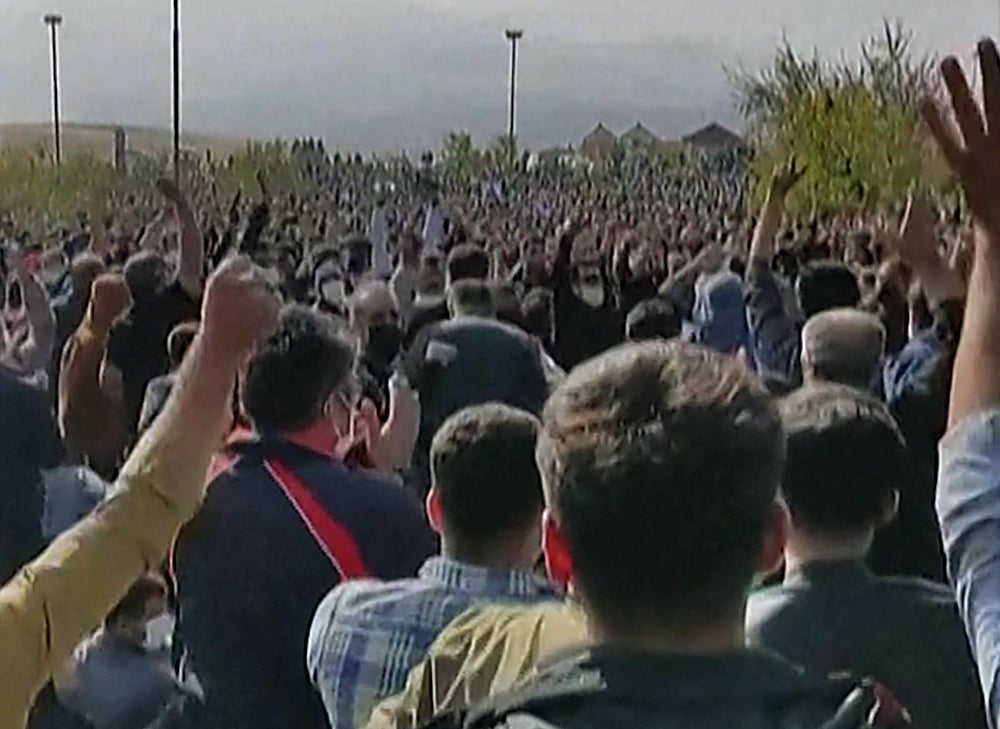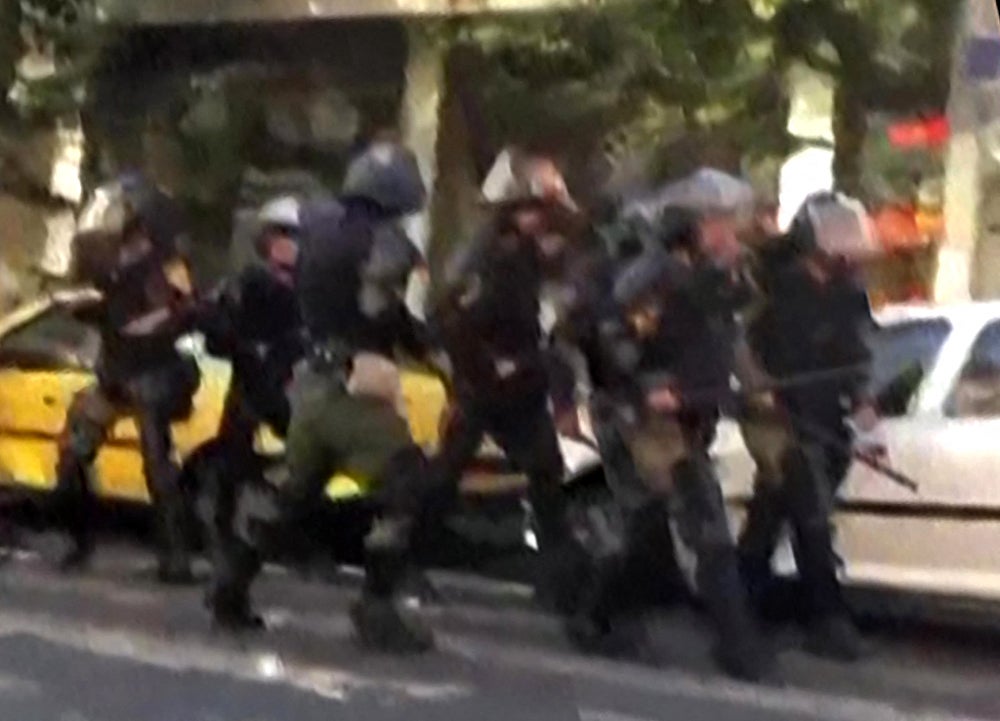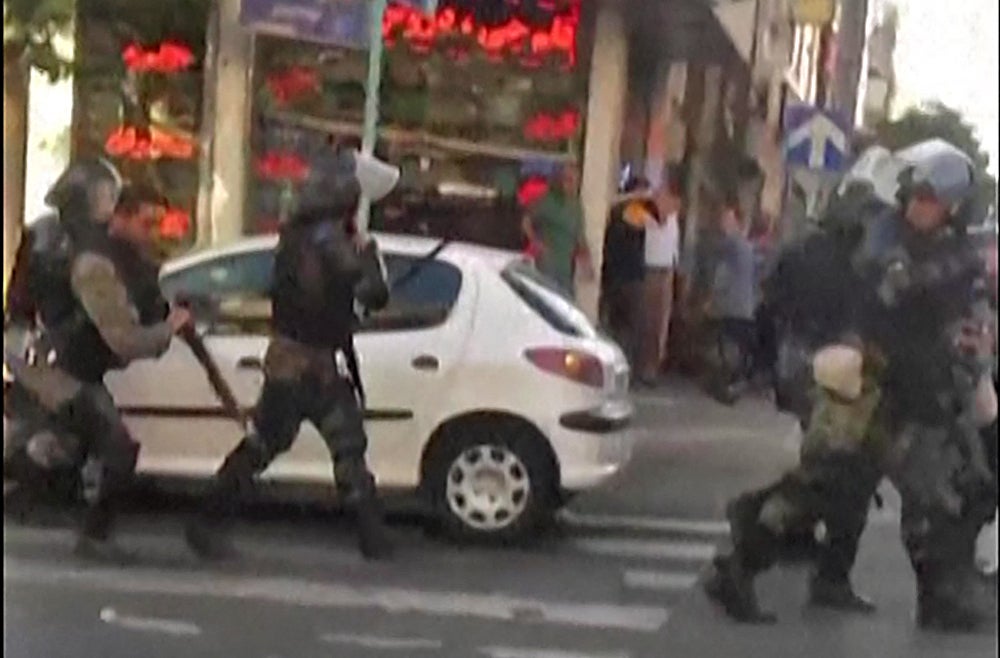‘Everyone knew their role’: How Iranians united on a night of dramatic protest against the regime
On Tehran’s Shariati Street, both sides geared up for battle in a confrontation that stretched into the night, as Borzou Daragahi reports


Your support helps us to tell the story
From reproductive rights to climate change to Big Tech, The Independent is on the ground when the story is developing. Whether it's investigating the financials of Elon Musk's pro-Trump PAC or producing our latest documentary, 'The A Word', which shines a light on the American women fighting for reproductive rights, we know how important it is to parse out the facts from the messaging.
At such a critical moment in US history, we need reporters on the ground. Your donation allows us to keep sending journalists to speak to both sides of the story.
The Independent is trusted by Americans across the entire political spectrum. And unlike many other quality news outlets, we choose not to lock Americans out of our reporting and analysis with paywalls. We believe quality journalism should be available to everyone, paid for by those who can afford it.
Your support makes all the difference.The burly, bearded men on motorcycles arrived early, racing up and down northern Tehran’s Shariati Street and menacing pedestrians with teargas rifles and paintball guns. But the protesters had started early as well, filling the pavements of the major commercial artery to gather and chant slogans on the 40th day following the death of Mahsa Amini.
Older residents also emerged from their apartments, sitting on benches to keep an eye out and maintain a presence. Drivers began flooding the roadway, honking their horns in support of the protests ahead of the impending showdown.
“It’s like everyone knew what they were supposed to do,” said one protester, a resident of one of the many neighbourhoods along Shariati Street that took part in what turned out to be the largest and most widespread protests across the capital. “My feeling is that people wanted to be out on the streets no matter what.”
Wednesday night’s protests turned out to be a watershed moment for the Iranian opposition to the Islamic Republic. Despite the regime having calculated that public anger would fizzle out, demonstrators came out in their largest numbers ever, including potentially tens of thousands in the country’s mostly Kurdish western areas who made their way to Amini’s grave.

Across the country, there were extraordinary and dramatic scenes. In Arak, activists lit a fire in the mountains looming above the city, in the shape of Amini’s first name. In Amol, in Iran’s north close to the Caspian Sea, protesters raised their arms and fell to the ground in front of armed regime enforcers, calling on them to open fire. In the town of Shahin Shahr, a small city in the country’s centre, protesters could be seen facing off against security forces, chanting simply “Iran! Iran!”
In Borujerd, near the hometown of slain 15-year-old protester Nika Shakarami, protesters seized control of the streets, holding up a banner that said, “Nika dear, we will avenge you.” The religiously significant 40th day since her death was marked by protests at the site of her grave.
Protests and unrest continued on Thursday, with videos of large gatherings in the Kurdish city of Mahabad following the death of protester Ismail Muludi, 35, a day earlier in the city. “Women, life, freedom!” protesters chanted in Kurdish, according to video footage.
Meanwhile, Iranian state broadcast outlets on Thursday all but ignored the protests, focusing on a still-mysterious attack on Wednesday on a shrine in Shiraz by purported Isis operatives from abroad that left 15 dead.

Numerous calls had gone out on social media urging protesters to gather on Wednesday on Shariati Street. The important north-south thoroughfare is named after Ali Shariati, a leftist intellectual who played a role in the thinking that led to Iran’s 1979 revolution. The street also includes a historically significant house of worship, Hosseinieh Ershad – where Shariati used to give speeches against the Shah that landed him in prison – as well as the massive and verdant compound that houses the British diplomatic residence, several hospitals, and numerous shopping centres.
It is a tree-lined street of mostly five- and six-storey apartment and office buildings of the sort typically seen in the capital, with a few larger towers in the mix. Wide rainwater canals run along both sides of the street, and the sound of water flowing sometimes mingles with the traffic.
Security forces were posted at the Hosseinieh Ershad, as well as at the Shariati metro station and other important sites along the street. As soon as a small group of protesters gathered and began shouting anti-regime slogans, the regime enforcers pounced.
“The special guards would open fire and they would chase people down side streets, and fire teargas into the streets, even in the small residential neighbourhoods,” said the protester. “They were trying to take the fight into the side streets. But the people would try to fight back and go back to the main street.”
Protesters, often strangers, consulted each other in makeshift tactical-operations meetings along pavements, sketching out the layouts of neighbourhoods in streets in order to figure out where to take the fight next.
“Even though there was fear, even though there was terror, even though there were threats and the motorcyclists started turning down the streets, the people wanted to be out there, doing what they could,” said the witness. “People who couldn’t handle the tension and chaos on the main street gathered on the side streets.”
Older residents stood at doorways, to allow protesters fleeing regime enforcers to escape.
As dusk fell and night settled, the violence became more severe. There were loud explosions, gunfire, and huge clouds of teargas wafting from Shariati into the nearby neighbourhoods. Then came groups of well-disciplined men on motorcycles, likely extremist Ansar Hezbollah militiamen, beating clubs in unison as they roamed Shariati in packs of up to a dozen. Many fired paintballs at protesters so that they could be identified and arrested later.
Still the protesters came out, often teenagers, emerging in waves as the night wore on, even past midnight. The security forces had concentrated so many personnel in the Shariati area, other parts of the city and other neighbourhoods were virtually free of regime shock troops.
“They were really trying to keep control of Shariati, but that meant that there were some places where there weren’t any security forces,” said the protester. “That meant that in some places people were chanting slogans and there were no security forces.”
The protester, a longtime Tehran resident who was active in the 2009 uprising that followed the disputed re-election of president Mahmoud Ahmadinejad, said that on Wednesday she saw people from demographic groups she had never before seen represented at protests, including the kind of chic apolitical youth one might have thought more likely to obsess over fashion than take part in these activities.
“I saw kids that would never do anything risky getting involved,” she said, “They were all wearing sporting outfits and running shoes. It was like everyone was ready to stay in the streets as much as possible.”
At one point she took off her headscarf and crossed the street, and all the drivers began honking their horns in support. She looked down the street and noticed that every single business along the busy commercial corridor was shuttered, having heeded calls to take part in a general strike for the day. The battles stretched past midnight, with waves of protesters heading out into the streets after catching their breath at home or in strangers’ homes. Videos showed large crowds of hundreds of people gathered on various parts of Shariati.
“It was as if they were waiting for something big to happen,” she recalled. “They were waiting for any opportunity to show their opposition. Everyone on the street knew their role, and everyone had a role in the protests. And I have a feeling the people will come out again.”
Join our commenting forum
Join thought-provoking conversations, follow other Independent readers and see their replies
Comments